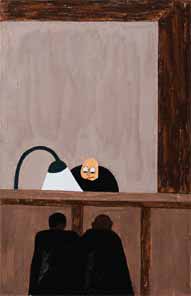|
|
 |
 |
 |

Click here to view a larger image |
Among the
social conditions that existed which was partly the cause of the migration
was the injustice done to the Negroes in the court.
The Migration of the Negro, panel
14, 1940-41. Casein tempera on hardboard, 18 x 12 in. (45.7 x 30.5
cm). The Museum of Modern Art, New York; gift of Mrs. David M. Levy
Artwork © Gwendolyn Knight Lawrence, courtesy of the Jacob and
Gwendolyn Lawrence Foundation
|
| |
|
 |
 indicates a link to another site
indicates a link to another site
After  Reconstruction
blacks in the South were stripped of political protection. Southern
states adopted Reconstruction
blacks in the South were stripped of political protection. Southern
states adopted  "Jim
Crow" laws, which imposed poll taxes, examinations,
property qualifications, and grandfather clauses limiting the ability
of blacks to vote. Laws also required blacks to use separate public
amenities, including separate educational and transportation facilities. "Jim
Crow" laws, which imposed poll taxes, examinations,
property qualifications, and grandfather clauses limiting the ability
of blacks to vote. Laws also required blacks to use separate public
amenities, including separate educational and transportation facilities.
It was difficult, if not impossible, for African Americans in the
South to demand justice. One migrant from Virginia said that in the
South blacks had to be very careful not to offend anyone, "because
they knowed that the least little thing you would do, they would kill
ya."1 Fear of lynching haunted southern blacks as
they suffered violence from the  Ku
Klux Klan and from the legal institutions of southern society. Ku
Klux Klan and from the legal institutions of southern society.
In southern courts, blacks were not afforded the same legal protection
as whites and they had little access to legal defense. They were given
summary trials that all too often resulted in a death sentence and
execution. Many migrants cited these social conditions as a reason
for their move to the North.
In this painting, two African Americans are receiving a verdict from
the judge who towers over them from behind the bench. The defendants
are anonymous, and the judge appears to avoid eye contact with them.
Lawrence positioned the viewer behind the defendants as though he
or she is witnessing the court case.
1. Spencer Crew, Field to Factory: Afro-American
Migration 1915-1940 (Washington, D.C.: National Museum of American
History, Smithsonian Institute, 1987), p. 12. |
|
|

• Think about an issue of injustice that
concerns our society today. Imagine that it is your job to create a campaign
that raises public awareness about this issue. You can design buttons, bumper
stickers, posters, a web page, television, or radio announcements to spread
your message. Develop a slogan for your campaign. If you like, choose a
spokesperson.
• You may want to research other campaigns that have raised awareness
about issues of injustice, for example,  Guerilla
Girls. How could you use art work to help your campaign? Guerilla
Girls. How could you use art work to help your campaign? |









